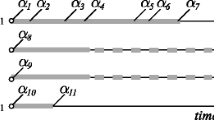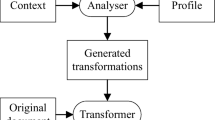Summary
The multiplication of presentation contexts (such as mobile phones, PDAs) for multimedia documents requires the adaptation of document specifications. In an earlier work, a semantic approach for multimedia document adaptation was proposed. This framework deals with the semantics of the document composition by transforming the relations between multimedia objects. In this chapter, we apply the defined framework to the hypermedia dimension of documents, i.e., hypermedia links between multimedia objects. By considering hypermedia links as particular objects of the document, we adapt the hypermedia dimension with the temporal dimension. However, due to the non-deterministic character of the hypermedia structure, the document is organized in several loosely dependent sub-specifications. To preserve the adaptation framework, we propose a first straightforward strategy that consists of adapting all sub-specifications generated by the hypermedia structure. Nevertheless, this strategy has several drawbacks, e.g., the profile is not able to change between user interactions. Hence, we propose an incremental approach which adapts document sub-specifications step by step according to these interactions. To validate this framework, we adapt real standard multimedia documents such as SMIL documents.
Access this chapter
Tax calculation will be finalised at checkout
Purchases are for personal use only
Preview
Unable to display preview. Download preview PDF.
Similar content being viewed by others
References
Nabil R. Adam, Vijayalakshmi Atluri, Igg Adiwijaya, Sujata Banerjee, and Richard Holowczak. A dynamic manifestation approach for providing universal access to digital library objects. IEEE Transactions on Knowledge and Data Engineering, 13(4):705–716, 2001.
James Allen. Maintaining knowledge about temporal intervals. Communications of the ACM, 26(11):832–843, 1983.
Mariam Kimiaei Asadi and Jean-Claude Dufourd. Knowledge-based and semantic adaptation of multimedia content. In Paola Hobson, Ebroul Izquierdo, Yiannis Kompatsiaris, and Noel E. O’Connor, editors, Knowledge-Based Media Analysis for Self-Adaptive and Agile Multimedia Technology, pages 285–293, 2004.
Paul De Bra, Peter Brusilovsky, and Geert-Jan Houben. Adaptive hypermedia: from systems to framework. ACM Computing Surveys, 31(4), 1999.
Paul De Bra and Natalia Stash. Multimedia adaptation using AHA! In Proceedings of the World Conference on Educational Multimedia, Hypermedia and Telecommunications, pages 563–570, 2004.
Jérôme Euzenat, Nabil Layaïda, and Victor Dias. A semantic framework for multimedia document adaptation. In Proceedings of the 18th International Joint Conferences on Artificial Intelligence, pages 31–36. Morgan Kauffman, 2003.
Luis Francisco-Revilla and Frank Shipman. MASH: A framework for adaptive spatial hypermedia. In Proceedings of the Third Workshop on Spatial Hypertext, ACM Hypertext Conference, 2003.
Christian Freksa. Temporal reasoning based on semi-intervals. Artificial Intelligence, 54(1–2):199–227, 1992.
Muriel Jourdan, Nabil Layaïda, Cécile Roisin, Loay Sabry-Ismaïl, and Laurent Tardif. Madeus, an authoring environment for interactive multimedia documents. In Proceedings of the 6th ACM Multimedia conference, pages 267–272, 1998.
Sébastien Laborie. Spatio-temporal proximities for multimedia document adaptation. In Proceedings of the 12th International Conference on Artificial Intelligence: Methodology, Systems, Applications, pages 128–137, 2006.
Sébastien Laborie, Jérôme Euzenat, and Nabil Layaïda. A spatial algebra for multimedia document adaptation. In Poster Proceedings of the First International Conference on Semantic and Digital Media Technologies, pages 7–8, 2006.
A. H. Land and A. G. Doig. An automatic method for solving discrete programming problems. Econometrica, 28(3):497–520, 1960.
Tayeb Lemlouma and Nabil Layaïda. The negotiation of multimedia content services in heterogeneous environments. In Proceedings of the 8th International Conference on Multimedia Modeling, pages 187–206, 2001.
Bernhard Nebel. Solving hard qualitative temporal reasoning problems: Evaluating the efficiency of using the ORD-horn class. In Proceedings of the 12th European Conference on Artificial Intelligence, pages 38–42, 1996.
Cécile Roisin. Authoring structured multimedia documents. In Proceedings of the Conference on Current Trends in Theory and Practice of Informatics, pages 222–239, 1998.
Lloyd Rutledge, Brian Bailey, Jacco van Ossenbruggen, Lynda Hardman, and Joost Geurts. Generating presentation constraints from rhetorical structure. In Proceedings of the 11th ACM on Hypertext and hypermedia, pages 19–28. ACM Press, 2000.
Ansgar Scherp and Susanne Boll. mobileMM4U – framework support for dynamic personalized multimedia content on mobile systems. In Proceedings of Techniques and Applications for Mobile Commerce (TaMoCO), pages 204–215, 2004.
Jacoo van Ossenbruggen, Frank J. Cornelissen, Joost Geurts, Lloyd Rutledge, and Lynda Hardman. Cuypers: a semi-automatic hypermedia generation system. Technical Report INS-R0025, CWI, Amsterdam (NL), 2000.
W3C. Scalable Vector Graphics (SVG), 1999. http://www.w3.org/ Graphics/SVG/.
W3C. Composite Capability/Preference Profiles (CC/PP): Structure and Vocabularies, 2001. http://www.w3.org/TR/CCPP-struct-vocab/.
W3C. Synchronized Multimedia Integration Language (SMIL 2.0) Specification, 2001. http://www.w3.org/TR/smil20/.
Author information
Authors and Affiliations
Editor information
Editors and Affiliations
Rights and permissions
Copyright information
© 2008 Springer-Verlag Berlin Heidelberg
About this chapter
Cite this chapter
Laborie, S., Euzenat, J. (2008). An Incremental Framework for Adapting the Hypermedia Structure of Multimedia Documents. In: Wallace, M., Angelides, M.C., Mylonas, P. (eds) Advances in Semantic Media Adaptation and Personalization. Studies in Computational Intelligence, vol 93. Springer, Berlin, Heidelberg. https://doi.org/10.1007/978-3-540-76361_8
Download citation
DOI: https://doi.org/10.1007/978-3-540-76361_8
Publisher Name: Springer, Berlin, Heidelberg
Print ISBN: 978-3-540-76359-8
Online ISBN: 978-3-540-76361-1
eBook Packages: EngineeringEngineering (R0)




